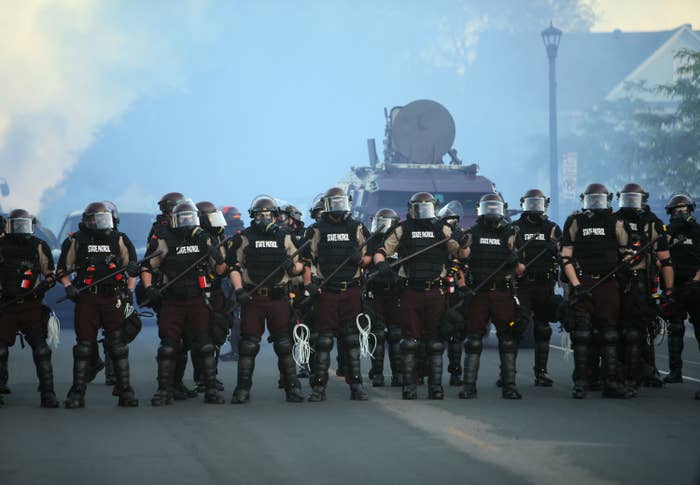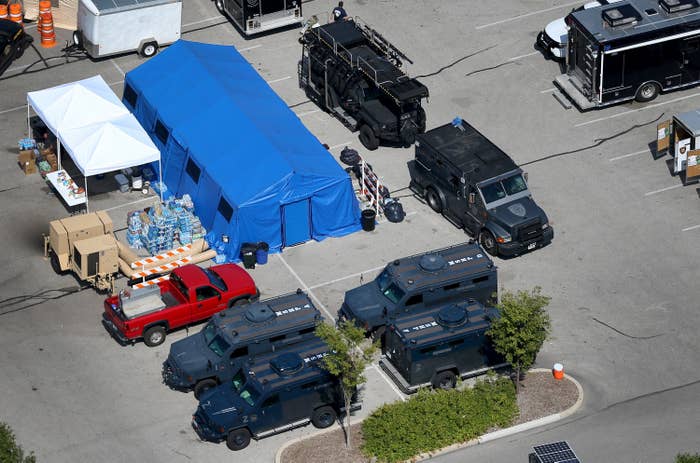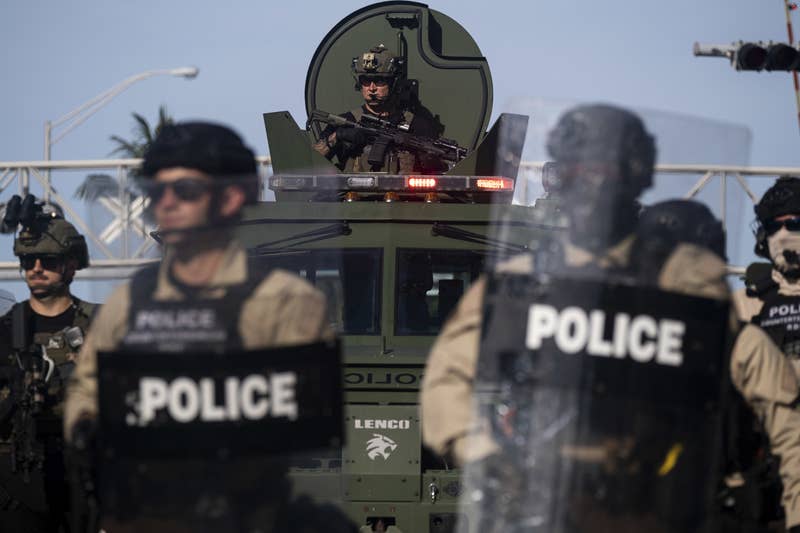The Defense Department’s "1033” military-equipment program has come under heavy scrutiny, but local law enforcement are continuing to receive supplies.
John TemplonBuzzFeed News Reporter
Posted on June 4, 2020
GO HERE TO SEE GRAPHS ACCOMPANING ARTICLE
https://www.buzzfeednews.com/article/johntemplon/police-departments-military-gear-1033-program

Scott Olson / Getty Images
Police prepare to confront demonstrators who are protesting the killing of George Floyd, May 30 in Minneapolis.
Police wearing full-body riot gear are driving armored vehicles through the streets of America’s cities in response to the protests across the nation sparked by the killing of George Floyd in Minneapolis.
The scenes recall the 2014 protests in Ferguson, Missouri, over another police killing, when public outcry over what appeared to be a massively disproportionate show of force brought scrutiny to a federal program that transfers unused military equipment to local law enforcement. The Ferguson Police Department was a beneficiary of that Department of Defense arrangement, known as the 1033 program.

Joe Raedle / Getty Images
Police tactical vehicles are seen parked at the police command center after protests and riots along Florissant Avenue in response to Michael Brown's shooting by a police officer, Aug. 24, 2014, in Ferguson, Missouri.
But despite pledges from public officials including then-president Barack Obama to review and restrict the program, the spigot of battlefield-caliber heavy equipment never stopped flowing.
Since Ferguson, in fact, local law enforcement agencies have received more than $850 million worth of equipment through the DoD program, according to a BuzzFeed News analysis of federal data. The 1033 program is broad and includes a wide range of supplies (some of the gear is as benign as coffee makers), but the haul also includes heavily armored personnel carriers, aircraft, ammunition, and other military equipment.
While there are many ways for law enforcement agencies to acquire military-grade equipment, including outright purchases and grants, the 1033 program remains an important way for agencies to acquire big-ticket items at little to no cost.
The program, which expanded on prior efforts to dispose of surplus military gear, was created under the Clinton administration and authorized "all law enforcement agencies to acquire property for bona fide law enforcement purposes that assist in their arrest and apprehension mission." The emphasis in the legislation was to focus on preventing terrorism and drug trafficking, rather than crowd and riot control.
Critics, including former Congress member Duncan Hunter and Sen. Rand Paul, have repeatedly warned that the gear is “excessive” and blurs the lines between military and police tactics. A December 2014 White House review of the 1033 program found that the transfers “can foster an environment at the local level in which it is difficult to distinguish between the appropriate military use and the appropriate [law enforcement agency] use of the same equipment
There are also concerns that the federal government does not provide local law enforcement with proper training on how to use potentially lethal equipment — or, for that matter, even whether it manages to keep track of what goes where.
In a 2017 audit, the Government Accountability Office was able to acquire over 100 controlled items, “including night vision goggles, simulated rifles, and simulated pipe bombs, which could be potentially lethal items if modified with commercially available items,” with a total value estimated at $1.2 million, from the 1033 program by creating a “fictitious federal law enforcement agency” to file an application.
Public officials have, in the past, appeared to heed such concerns, particularly in the wake of the Ferguson protests, which were sparked by the fatal shooting of Michael Brown, an unarmed black teen, by a white police officer.
“At a time when we must seek to rebuild trust between law enforcement and the local community, I am deeply concerned that the deployment of military equipment and vehicles sends a conflicting message,” said then-attorney general Eric Holder in a statement on Aug. 14, 2014. The following May, Obama issued an executive order that prohibited the transfer of certain items from the 1033 program, including bayonets and grenade launchers, while requiring law enforcement agencies to provide more information in order to get others, such as tactical vehicles and riot gear.
But that order was rescinded in August 2017 by the Trump administration, removing much of the oversight of the program and allowing more equipment to be transferred. “Those restrictions went too far,” said then-attorney general Jeff Sessions. “We will not put superficial concerns above public safety.”
The Department of Defense’s data shows only how much equipment is currently held by law enforcement agencies, and does not track equipment that was received and subsequently disposed of, or returned to the federal government. Still, as of this March, the arsenals of local law enforcement agencies currently include 494 mine-resistant vehicles, at least 800 pieces of body armor, more than 6,500 rifles, and at least 76 aircraft acquired through the 1033 program post-Ferguson.
The mine-resistant vehicles, which can weigh about 24 tons, stand up to 13 feet tall, and have a gun turret on top, were designed to withstand improvised explosive devices and ambushes in war zones such as Iraq and Afghanistan, rather than to assist with crowd control. No police agency currently possesses more than two of the vehicles that were transferred since Ferguson, but many have gone to tiny, often rural departments with fewer than 50 officers.
Larger departments have also recently received the vehicles, known as MRAPs. The New York City Police Department, for example, received at least two through the 1033 in recent years, as has the Memphis Police Department. The Ramsey County Sheriff's Department in Minnesota, which contains the city of St. Paul, also received one in 2016. Jefferson County, Alabama, which contains Birmingham, received one this year.
The largest single recipient of body armor has been the Milwaukee Police Department, which has taken in more than 250 pieces since August 2014. The Pentagon has also given out more than 200 riot control face and body shields to departments around the country.
Aircraft — which can be used for surveillance, transport, and crowd control — have been hotly sought after as well. The Arizona Department of Public Safety, for example, acquired three fixed-wing aircraft in 2015, including two Skytruck planes. Aircraft from agencies of all sizes patrolled the skies above major protests this past weekend.
Now that protests over police violence have broken out again, and this time on a far larger scale, some of that military might is being put to use. Mine-resistant vehicles have been used throughout the country over the past week, in cities including Minneapolis, Miami, and Washington, DC.

Ricardo Arduengo / Getty Images
A Miami Police officer watches protesters from an armored vehicle during a rally in response to the recent death of George Floyd in Miami, May 31.
In response, some politicians have again begun calling for more regulation of the Pentagon program. After Brian Schatz, a Democratic senator from Hawaii, tweeted on Monday that he would introduce legislation to “discontinue” the 1033 program, a staffer for Kentucky Republican Rand Paul, replied that his office would be glad to help with the effort.
Rep. Ruben Gallego, a Democrat from Arizona, said on Twitter on Monday that he will “push for the House to restrict the program that provides military gear to police departments.”
Notably, one of the items Sessions specifically mentioned when Obama’s executive order was rescinded were bayonets. Over the past 14 months, at least 167 of the rifle-mounted weapons have been sent to local law enforcement agencies, according to the data.
It is not clear, however, if any bayonets have been used to confront protesters in the past week.

John Templon is a data reporter for BuzzFeed News and is based in New York. His secure PGP fingerprint is 2FF6 89D6 9606 812D 5663 C7CE 2DFF BE75 55E5 DF99
No comments:
Post a Comment